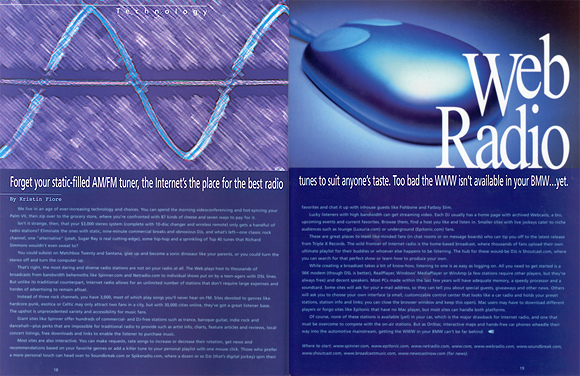
- Bertolt Brecht.


We live in an age of ever-increasing technology and choices. You can spend the morning videoconferencing and hot-syncing your Palm VII, then zip over to the grocery store, where you're confronted with 87 kinds of cheese and seven ways to pay for it. Isn't it strange, then, that your $3,000 stereo system (complete with 10-disc changer and wireless remote) only gets a handful of radio stations? Eliminate the ones with static, nine-minute commercial breaks and obnoxious DJs, and what's left -- one classic rock channel, “alternative” (yeah, Sugar Ray is real cutting-edge), some hip-hop and a sprinkling of Top 40 Tunes that Richard Simmons wouldn't even sweat to?
You could subsist on Matchbox Twenty and Santana, give up and become a sonic dinosaur like your parents, or you could turn the stereo off and turn the computer up. That's right, the most daring and diverse radio stations are not on your radio at all. The Web plays host to thousands of broadcasts from bandwidth behemoths like Spinner.com and Netradio.com to individual shows put on by teenagers with DSL lines. But unlike its traditional counterpart, Internet radio allows for an unlimited number of stations that don't require large expenses and hordes of advertising to remain afloat. Instead of three rock channels, you have 3,000, most of which play songs you'll never hear on FM. Sites devoted to genres like hardcore punk, exotica or Celtic may only attract two fans in a city, but with 30,000 cities online, they've got a great listener base. The upshot is unprecedented variety and accessibility for music fans. Giants like Spinner offer hundreds of commercial- and DJ-free stations like trance, baroque guitar, indie rock and dancehall -- plus perks that are impossible for traditional radio to provide such as artist info, charts, feature articles and reviews, local concert listings, free downloads and links to enable the listener to purchase music.
Most sites are also interactive. You can make requests, rate songs to increase or decrease their rotation, get news and recommendations based on your favorite genres or add a killer tune to your personal playlist with one mouse click. Those who prefer a more personal touch can head over to Soundbreak.com or Spikeradio.com, where a dozen or so DJs (that's digital jockey) spin their favorites and chat it up with inhouse guests like Fishbone and Fatboy Slim. Lucky listeners with high bandwidth can get streaming video. Each DJ usually has a home page with archived Webcasts, a bio, upcoming events and current faves. Browse them, find a host you like and listen in. Smaller sites with live jockeys cater to niche audiences such as lounge (Luxuria.com) or underground (Epitonic.com) fans. These are great places to meet like-minded fans (in chat rooms or on message boards) who can tip you off to the latest release from Triple X Records.
The wild frontier of Internet radio is the home-based broadcast, where thousands of fans upload their own ultimate playlist for their buddies or whoever else happens to be listening. The hub for these would-be DJs is Shoutcast.com, where you can search for that perfect show or learn how to produce your own.
While creating your own broadcast takes a bit of know-how, listening to one is as easy as logging on. All you need to get started is a 56K modem (though DSL or cable is better), RealPlayer, Windows' MediaPlayer or WinAmp (a few stations require other players, but they're always free) and decent speakers. Most PCs made within the last few years will have adequate memory, a speedy processor and a soundcard. Some sites will ask you for your e-mail address, so they can tell you about special guests, giveaways and other news. Others will ask you to choose your own interface (a small, customizable control center that resembles a car radio and holds your preset stations, song info and links; you can close the browser window and keep this one open). Mac users may have to download different players or forgo sites like Epitonic that have no Mac player, but most sites can handle both platforms.
Of course none of these stations is available (yet) in your car, which is the major drawback for Internet radio, and one that must be overcome to compete with on-air stations. But as OnStar, interactive maps and hands-free car phones wheedle their way into the automotive mainstream, getting the WWW into your BMW can't be far behind.